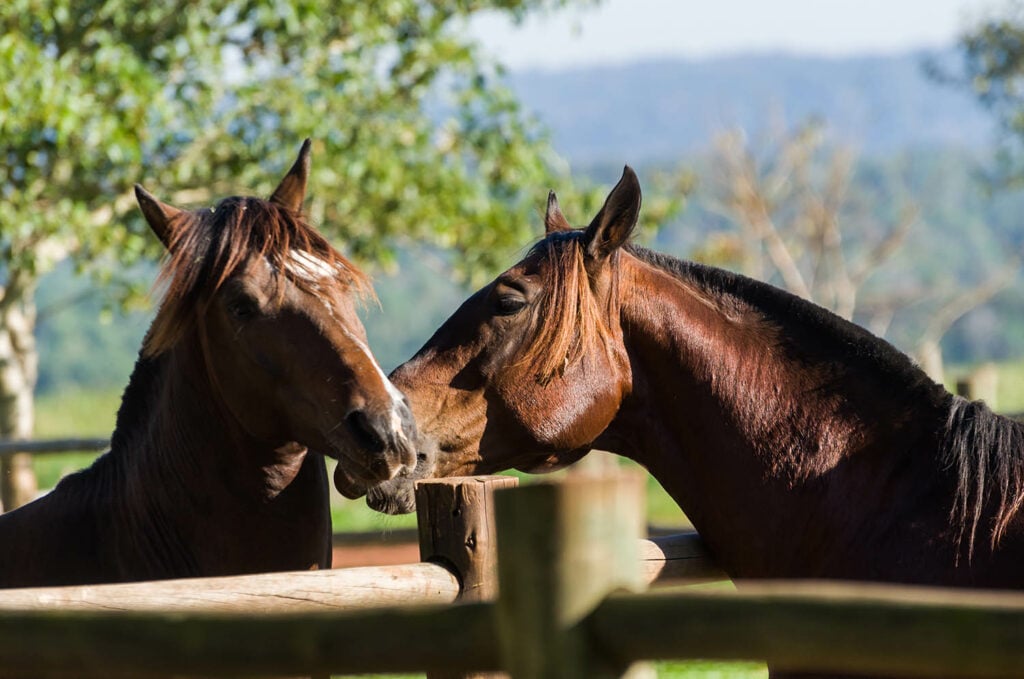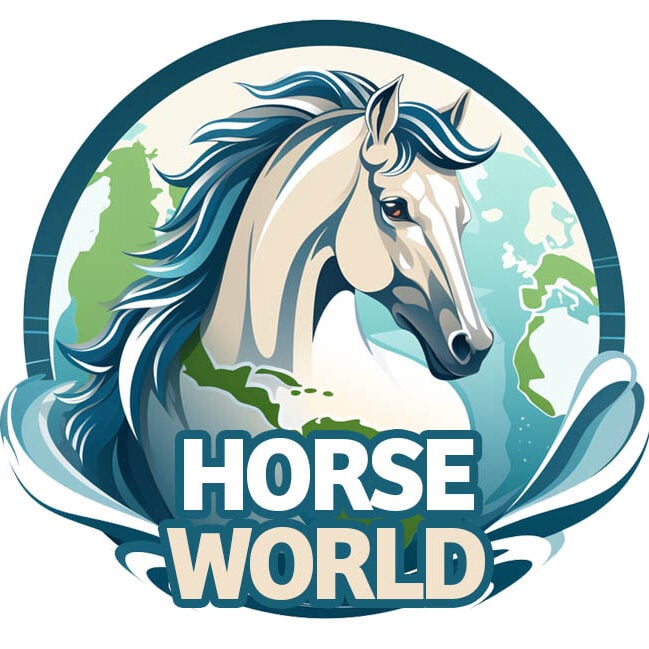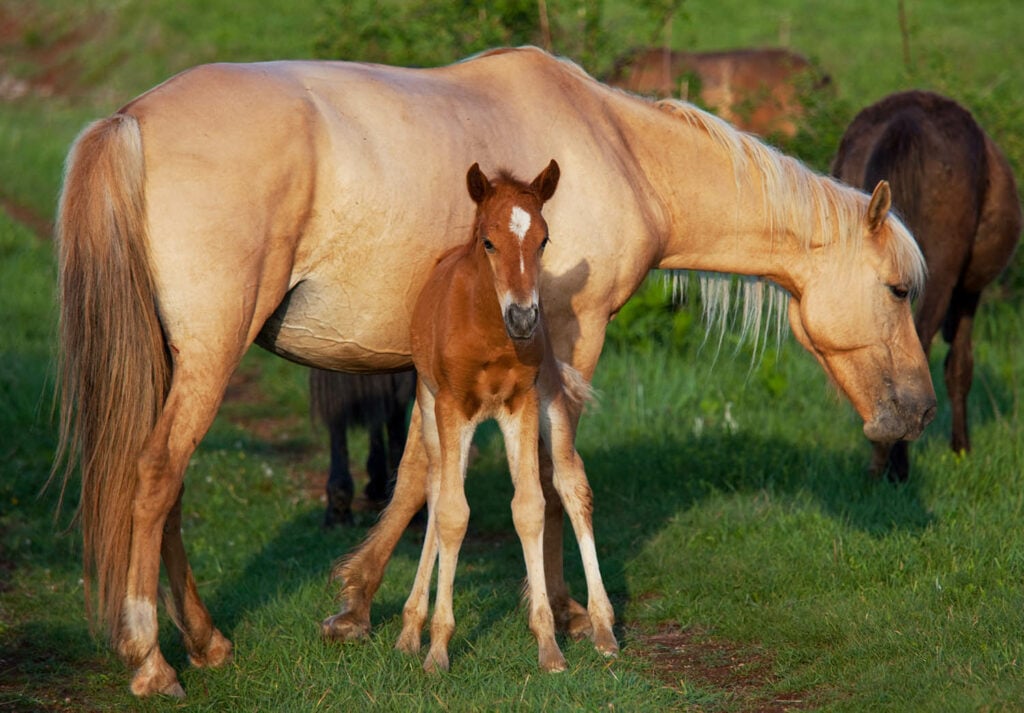Horses are known for their strength, beauty, and grace. They are magnificent creatures that have been domesticated for thousands of years. One of the most fascinating aspects of horses is their mating behavior. Horse mating is a complex process that involves several stages.
First, the male horse, also known as a stallion, will approach the female horse, or mare, and begin to court her. This involves nuzzling, licking, and nibbling on her neck and flanks. The stallion will also vocalize and prance around the mare to show off his strength and dominance. If the mare is receptive, she will respond by lifting her tail and urinating, which is a sign that she is ready to mate.
Once the stallion has mounted the mare, the actual act of mating takes only a few seconds. The stallion will ejaculate into the mare’s reproductive tract, and the sperm will travel up to the fallopian tubes where fertilization occurs. Horse mating is a natural and essential part of their reproductive cycle, and understanding the process can help horse breeders and owners ensure the health and well-being of their animals.
Understanding Horse Mating
Horse mating is a natural process that occurs when a stallion and a mare are both physically mature and experience sexual attraction. Horses are social animals and live in herds, with the highest-ranking stallion being the primary breeder.
During the courtship stage, the stallion will perform courtship rituals to attract the mare. This may include nuzzling, prancing, nickering, biting, kicking, chasing, rearing, fighting, snorting, sniffing, restlessness, and aggression. The mare may also display postures that show her interest in the stallion.
Once the mare is receptive, the mating stage begins. The stallion mounts the mare and the two engage in sexual intercourse. The mating process can last anywhere from a few seconds to several minutes. After mating, the mare may exhibit the flehmen response, which is a behavior where she curls her upper lip and inhales to better detect scents.
The postmating behavior stage begins after the mating is complete. The stallion may continue to show dominance over the mare and other horses in the herd. The mare may display behaviors such as kicking or biting to protect her foal.
In domestic horse breeding, humans may intervene to control the mating process and ensure the health and safety of the horses involved. However, in the wild, horse mating behavior is entirely natural and driven by natural selection.
In conclusion, understanding horse mating behavior is essential for horse breeders and enthusiasts. By observing and recognizing the courtship and mating stages, one can better understand the beauty and complexity of this natural process.
The Breeding Season
During the breeding season, which typically occurs in the spring and summer months, horses are at their most receptive to mating. This period is also known as the mating season, and it is when horses are considered to be seasonal breeders.
The breeding season is triggered by changes in daylight hours and temperature, which affect the mare’s estrus cycle. This cycle, also known as the heat cycle or estrous cycle, is controlled by hormones that regulate the mare’s reproductive system. As the days get longer and the weather gets warmer, mares begin to cycle more frequently, and their bodies become more receptive to breeding.
In the wild, stallions will compete for mares during the breeding season, and the strongest and most dominant stallions will have the greatest chance of mating. In domestic breeding programs, however, the breeding process is carefully managed to ensure the best possible genetic outcomes.
Breeding during the breeding season is typically done through natural breeding, where the stallion is allowed to mount the mare and mate naturally. However, artificial insemination is also commonly used in breeding programs, particularly for horses that are not able to mate naturally or for those that are being bred for specific traits.
Overall, the breeding season is a critical time for horse breeders, as it is when the majority of breeding takes place. By understanding the mare’s estrus cycle and carefully managing the breeding process, breeders can ensure the best possible outcomes for their horses.
The Reproductive Process
Horses are mammals that reproduce sexually. The reproductive process involves the fertilization of the mare’s egg by the stallion’s sperm, which results in the development of a foal.
The mare’s reproductive tract includes the ovaries, uterus, and vagina. The ovaries produce and release eggs, which travel through the oviducts to the uterus. The uterus is where the fertilized egg implants and develops into a foal. The vagina is the passage through which the foal is born.

The stallion’s reproductive tract includes the testes, epididymis, vas deferens, and penis. The testes produce and store sperm, which mature in the epididymis. The vas deferens is the tube that carries sperm from the epididymis to the penis. The penis is used to deposit semen into the mare’s reproductive tract during mating.
Mating occurs when the stallion mounts the mare. The stallion’s penis becomes erect and is inserted into the mare’s vagina. The stallion ejaculates semen into the mare’s reproductive tract, which contains millions of sperm. The sperm swim up the oviducts to reach the egg in the mare’s uterus. If a sperm successfully fertilizes the egg, the fertilized egg implants in the uterus and begins to develop into a foal.
The gestation period for horses is approximately 11 months. During this time, the foal grows and develops inside the mare’s uterus. The mare’s body undergoes many changes to support the growing foal, including an increase in blood volume and changes in hormone levels. When the foal is fully developed, the mare goes into labor and gives birth to the foal.
Artificial and Forced Breeding
Artificial insemination is a common method used to breed horses, especially in the racing industry. This process involves collecting semen from a stallion and then inserting it into the mare’s reproductive tract using a catheter. It is a quick and efficient method that allows breeders to use the semen from the best stallions without having to transport the mares to them.
In-hand breeding, on the other hand, involves bringing the mare to the stallion for mating. This method is often used in breeding programs that focus on preserving specific bloodlines. It can also be used when the mare is not a good candidate for artificial insemination.
Forced breeding, where human intervention is used to physically force the mare to mate with the stallion, is not a common practice in the horse breeding industry. It is generally considered inhumane and is illegal in many countries.
Overall, artificial insemination and in-hand breeding are the most common methods used to breed horses. They are efficient, safe, and effective ways to produce healthy foals.
Impact of Environment and Stress
The environment and stress can have a significant impact on the mating behavior of horses. Stressful situations, such as transportation, changes in diet, and social isolation, can affect the reproductive system of horses and their ability to mate.
Environmental factors such as temperature, humidity, and lighting can also impact the mating behavior of horses. For example, horses tend to mate more frequently during the spring and summer months when days are longer and temperatures are warmer. In contrast, during the winter months, horses may experience a decrease in libido due to colder temperatures and shorter days.

Stressful situations can also lead to changes in hormone levels, which can affect the reproductive cycle of horses. For example, prolonged stress can lead to an increase in cortisol levels, which can inhibit the production of reproductive hormones such as testosterone and progesterone.
In addition, social stress can also impact the mating behavior of horses. Horses that are isolated from other horses may experience a decrease in libido and may have difficulty mating. Similarly, horses that are housed with aggressive or dominant horses may experience stress and may have difficulty mating as well.
Overall, it is important to provide horses with a comfortable and stress-free environment to ensure optimal reproductive health and successful mating behavior.
Specific Horse Breeds and Mating
When it comes to horse breeding, different breeds have their unique characteristics. Here are some specific horse breeds and mating information:
Arabians
Arabians are known for their beauty, stamina, and intelligence. They are one of the oldest horse breeds globally and have a unique mating process. Arabians have a high fertility rate, and they can mate at any time of the year. The mating process for Arabians is relatively straightforward, and the stallion and mare can mate naturally or through artificial insemination.
Thoroughbreds
Thoroughbreds are a popular horse breed for racing and jumping. They are known for their speed and agility. Thoroughbreds can mate naturally or through artificial insemination. Mating thoroughbreds can be a bit tricky because they are sensitive to their environments. They require a comfortable and stress-free environment to mate successfully.
American Quarter Horse
The American Quarter Horse is a versatile breed that is popular for ranch work, racing, and rodeo events. They are known for their speed and intelligence. Mating American Quarter Horses can be done naturally or through artificial insemination. They have a high fertility rate and can mate at any time of the year.
Wild Horses
Wild horses are not a specific breed, but they are domesticated horses that have returned to the wild. Mating wild horses can be challenging because they are not used to human interaction. They mate naturally, and the stallion usually fights for the right to mate with the mare.
Domesticated Horses
Domesticated horses are bred for different purposes, including racing, riding, and ranch work. Mating domesticated horses can be done naturally or through artificial insemination. The process is relatively straightforward, and the mare and stallion can mate at any time of the year.
Ponies
Ponies are smaller than horses and are often used for riding by children. Mating ponies can be done naturally or through artificial insemination. They have a high fertility rate and can mate at any time of the year.
In conclusion, different horse breeds have their unique mating processes. Mating can be done naturally or through artificial insemination, and the environment and timing are crucial for a successful mating.
Mating and Human History
Horses have been domesticated for thousands of years, and their mating rituals have been observed and studied by humans for just as long. In fact, the history of human interaction with horses is closely tied to their breeding and reproduction.
Equestrians have long been interested in breeding horses for specific traits, such as speed, strength, and endurance. This interest has led to the development of various competitions and races that showcase the best of these traits. Age-based competitions, for example, often require horses to be of a certain age to participate, ensuring that only the strongest and most mature animals are chosen.
Preparing horses for mating is also an important part of equestrian culture. Horses are often groomed and trained to be in optimal physical condition before breeding. This can include everything from exercise and diet to grooming and veterinary care.
Despite the importance of horse breeding in human history, the actual mating process is relatively simple. Horses typically mate in the spring or summer, when the weather is warm and the days are long. The mare is receptive to the stallion’s advances and will often present herself to him by lifting her tail and urinating. The stallion will then mount the mare and begin the mating process.
Overall, the mating rituals of horses have played an important role in human history and continue to be an important part of equestrian culture today. By understanding the basics of horse breeding, equestrians can continue to breed and raise strong, healthy horses for generations to come.

